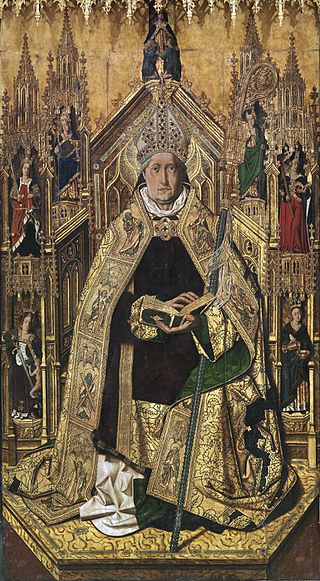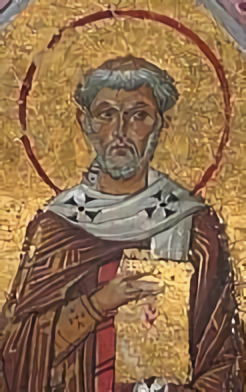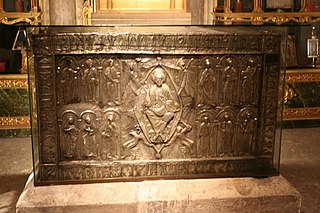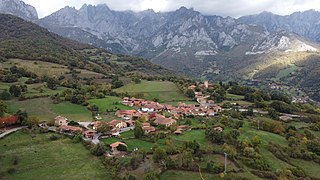
Abbot is an ecclesiastical title given to the head of an independent monastery for men in various Western Christian traditions. The name is derived from abba, the Aramaic form of the Hebrew ab, and means "father". The female equivalent is abbess.
Pope Zosimus was the bishop of Rome from 18 March 417 to his death on 26 December 418. He was born in Mesoraca, Calabria. Zosimus took a decided part in the protracted dispute in Gaul as to the jurisdiction of the See of Arles over that of Vienne, giving energetic decisions in favour of the former, but without settling the controversy. His fractious temper coloured all the controversies in which he took part, in Gaul, Africa and Italy, including Rome, where at his death the clergy were very much divided.

Pope Leo I, also known as Leo the Great, was Bishop of Rome from 29 September 440 until his death.

Pope Hilarius was the bishop of Rome from AD 461 to 468.

Pope Simplicius was the bishop of Rome from 468 to his death. He combated the Eutychian heresy, ended the practice of consecrating bishops only in December, and sought to offset the effects of Germanic invasions.

Astorga is a municipality and city of Spain located in the central area of the province of León, in the autonomous community of Castilla y León, 43 kilometres (27 mi) southwest of the provincial capital. It is located in the transit between the Páramo Leonés and the mountains of León and acts as the backbone of the comarcas of Maragatería, La Cepeda and the Ribera del Órbigo. The city is the head of one of the most extensive and oldest dioceses of Spain, whose jurisdiction covers half of the province of León and part of Ourense and Zamora. It is also head of the judicial party number 5 of the province of León.
Priscillian was a wealthy nobleman of Roman Hispania who promoted a strict form of Christian asceticism. He became bishop of Ávila in 380. Certain practices of his followers were denounced at the Council of Zaragoza in 380. Tensions between Priscillian and bishops opposed to his views continued, as well as political maneuvering by both sides. Around 385, Priscillian was charged with sorcery and executed by authority of the Emperor Maximus. The ascetic movement Priscillianism is named after him, and continued in Hispania and Gaul until the late 6th century. Tractates by Priscillian and close followers, which were thought lost, were discovered in 1885 and published in 1889.
Pope John XVIII was the bishop of Rome and nominal ruler of the Papal States from January 1004 to his abdication in July 1009. He wielded little temporal power, ruling during the struggle between John Crescentius and Emperor Henry II for the control of Rome.

Beatus of Liébana was a monk, theologian, and author of the Commentary on the Apocalypse, mostly a compendium of previous authorities' views on the biblical Book of Revelation or Apocalypse of John. This had a local influence, mostly in the Iberian Peninsula, up to about the 13th century, but is today remembered mainly for the 27 surviving manuscript copies that are heavily illustrated in an often spectacular series of miniatures that are outstanding monuments of Mozarabic art. Examples include the Morgan Beatus and Saint-Sever Beatus; these are covered further at the article on the book. Most unusually for a work of Christian theology, it appears that Beatus always intended his book to be illustrated, and he is attributed with the original designs, and possibly the execution, of the first illustrations, which have not survived.

April 15 - Eastern Orthodox liturgical calendar - April 17

The Monastery of Santo Toribio de Liébana is a Roman Catholic monastery located in the district of Liébana, near Potes in Cantabria, Spain. Located in the Cantabrian Mountains in northern Spain, the monastery is one of the five places in Roman Catholicism, together with Rome, Jerusalem, Santiago de Compostela and Caravaca de la Cruz, that has the privilege of issuing perpetual indulgences.
Toribio or Toribío may refer to:

Toribio Alfonso de Mogrovejo was a Spanish Catholic prelate who served as Archbishop of Lima from 1579 until his death.
Turibius or Toribius is the name of several saints:

The Seminary of Saint Turibius, also known as the Seminary of Lima or, is a priestly seminary in charge of training seminarians to be future priests of the Roman Catholic Archdiocese of Lima. It is based in Lima, Peru, and is the second oldest seminary in the Americas after that of Bogotá, having been founded on December 7, 1591, by then Archbishop Turibius of Mongrovejo.

The Diocese of Astorga is a Latin Church diocese of the Catholic Church whose seat is in the city of Astorga, in the province of León, Castile and León, Spain.

Turibius of Liébana, also known as Turbius the Monk, was an early Benedictine monk. He was born probably in Turieno and spent most of his life in the region of Liébana. He received a letter full of praise from Bishop Montanus of Toledo in 527. In his preaching, he condemned as heresy the Priscillianism still rampant in Spain. Around the middle of the century, he and five companions took up the Benedictine habit and founded the monastery of Liébana, either the second or third oldest Benedictine establishment in Spain, dedicating it to Martin of Tours.

The Arca Santa is an oak reliquary covered with silver-gilt decorated in the Romanesque style. It is kept in the Cámara Santa of the Cathedral of San Salvador in Oviedo. In 1934 the Cámara Santa suffered an explosion that severely damaged the Arca, which was carefully restored by Manuel Gómez-Moreno.

The Diocese of Geneva was a Latin Church ecclesiastical jurisdiction or diocese in part of Switzerland and Savoy from 400 to 1801, when it merged with the Diocese of Chambéry. The merged diocese was later broken up, due to changes in national boundaries. The diocese of Chambéry lost Swiss territory to the Diocese of Lausanne, Geneva and Fribourg.

Mogrovejo is a small village of the municipality of Camaleño in Cantabria, Spain with 44 inhabitants in 2008.













